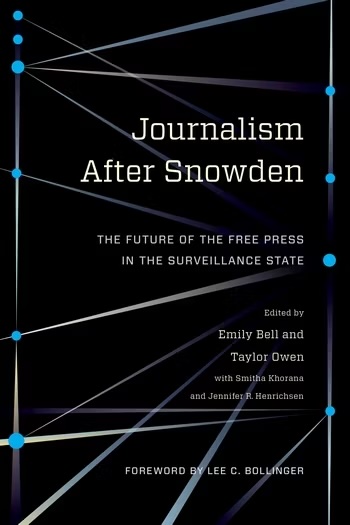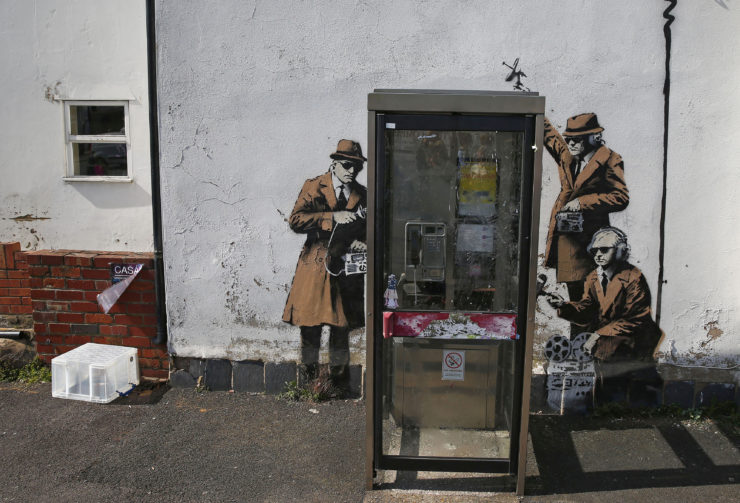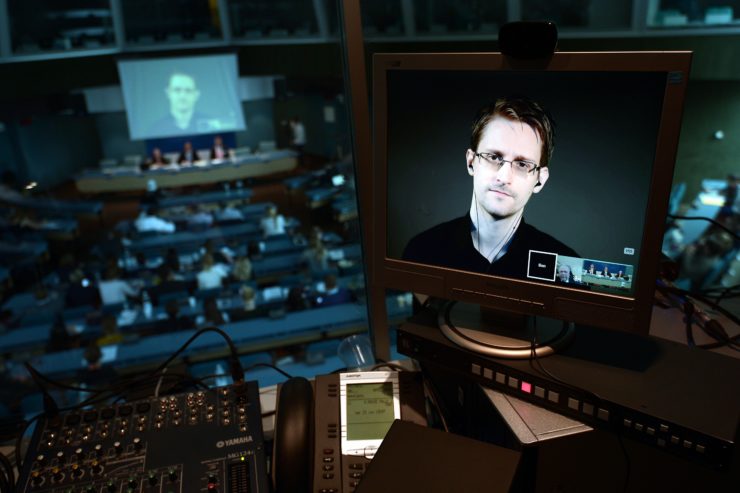
In the age of heightened surveillance, the need for—and threat to—watchdog journalism has intensified, with Edward Snowden’s 2013 leak of classified documents signaling what may become a new norm in national security coverage. The impact of surveillance on investigative journalism is among the topics explored in the anthology “Journalism After Snowden: The Future of the Free Press in the Surveillance State,” edited by Emily Bell and Taylor Owen and published by Columbia University Press today. It includes a conversation between Bell and Snowden and an essay by former Guardian reporter Glenn Greenwald who in 2013 broke the news of the Snowden revelations.
In “Political Journalism in a Networked Age,” Internet and society scholar Clay Shirky discusses what actions journalists and publications must take to augment their ability to report newsworthy stories while minimizing government interference. An edited excerpt:
After [Edward] Snowden, we see how much power now lies with the leaker. Snowden demonstrated that the principal value WikiLeaks had provided was not in receiving the source materials but in coordinating a multinational network of publishers. Snowden himself took on this function, contacting Laura Poitras and Glenn Greenwald directly.
The potential for a global news network has existed for a few decades, but its practical implementation is unfolding in ours. This normalization of transnational reporting networks reduces the risk of what engineers call a “single point of failure.” As we saw with Bill Keller’s craven decision not to publish James Risen’s work on the National Security Agency in 2004, neither the importance of a piece of political news nor its existence as a scoop is enough to guarantee that that it will actually see the light of day. The global part is driven by the need for leakers to move their materials outside national jurisdictions. The network part is driven by the advantages of having more than one organization with a stake in publication.

The geographic spread of the information means that there is no one legal regime in which injunctions on publication can be served, while the balance of competition and collaboration between organizations removes the risk of an editor unilaterally killing newsworthy coverage. Now and for the foreseeable future, the likelihood that a leak will appear in a single publication, in the country in which it is most relevant, will be in inverse proportion to the leak’s importance.
These two changes—the heightened leverage of sources and the normalization of transnational news networks—are threatening even to democratic states with constitutional protections for the press (whether de jure, as in the United States, or de facto, as in the United Kingdom). Those governments always had significant extralegal mechanisms for controlling leaks at their disposal, but empowered sources and transnational networks threaten those mechanisms.
This containment of journalistic outlets inside national borders resembled a version of the prisoner’s dilemma, a social science thought experiment in which each of two people is given a strong incentive to pursue significant short-term gain at the other’s expense. At the same time, each participant has a weaker but longer-lasting incentive to create small but mutual, longer-term value. The key to the prisoner’s dilemma is what Robert Axelrod, its original theorist, calls “the shadow of the future.” The shadow of the future is what keeps people cooperating over the long term—in friendships, businesses, marriages, and other relationships—despite the temptations of short-term defection of all sorts.
News outlets and governments exist in a version of the prisoner’s dilemma. Publications have a short-term incentive to publish everything they know, but a long-term incentive to retain access to sources inside the government. Governments have a short-term incentive to prevent news outlets from discovering or publishing anything, but a long-term incentive to be able to bargain for softening, delaying, or killing the stories they really don’t want to see in public (as happened with Keller.)
As long as both institutions have an extended time horizon, neither side gets all of what it wants, but neither side suffers the worst of what it fears, and so the relationship bumps along, year after year. (There have been a few counterexamples: I. F. Stone did all his work for his weekly newsletter by researching government data, never interviewing politicians or civil servants. He reasoned that the quid pro quo of increased access but reduced ability to publish would end up creating more restrictions than it was worth.)
The shadow of the future has meant that even in nations with significant legal protections for free speech, the press’s behavior is considerably constrained by mutual long-term bargains with the government. Empowered leakers and transnational publication networks disrupt this relationship. A leaker with a single issue—the world should see what the State Department or the NSA is doing, to take the two obvious examples—has no regard for the shadow of the future, while publications outside the United States will be not be constrained by legal challenges, threatened loss of insider access, or appeals to patriotism.
There is one final pattern that the Snowden leaks make visible. In the middle of the twentieth century, mainstream news both relied on and produced cultural consensus. With the erosion of the belief that mainstream media speaks to and for the general public in an unbiased way, the presumed lack of objectivity of any given news organization has become a central concern. Alongside this change, however, we are witnessing the spread of a new form of objective reporting: reporting done by objects.
There are, of course, precedents to object-based reporting; tape-recorded conversations in Nixon’s White House ended his presidency, as his foulmouthed, petty vindictiveness became obvious to all. The heroic work of The Washington Post is the stuff of journalistic lore, but the mechanical nature of the tape recorders actually made them the most trusted reporters on the story.
As the quality and range of reporting by objects has increased, it has had the curious effect of making the partisan nature of both reporters and publications a less serious issue. If Mother Jones, predictably liberal, had been able to report Mitt Romney’s remarks about the 47 percent only because a bartender heard and repeated them, the story would have circulated among the magazine’s left-leaning readers but no farther (as with most stories in that publication). That bartender recorded the conversation, however, and the fact of the recording meant Mother Jones’s reputation didn’t become a serious point of contention. Because people had to trust only the recording, not the publication, the veracity of the remarks was never seriously challenged.
This pattern of objective recording trumping partisan reputation is relatively new. Indeed, in the 47 percent story, otherwise sophisticated political observers like Jonathan Chait predicted that Romney’s remarks would have little real effect, because they didn’t understand that the existence of a recording simply neutralized much of the “out of context” and “he said, she said” posturing that usually follows. Mother Jones no longer had to be mainstream to create a mainstream story, provided that its accuracy was vouched for by the bartender’s camera.
In Snowden’s case, many of the early revelations about the NSA, and especially the wholesale copying of data flowing through various telecom networks, had already been reported, but that reporting had surprisingly little effect. The facts of the matter weren’t enough to alter the public conversation. What did have an effect was seeing the documents themselves.

All inter-office PowerPoint decks are bad, but no one does them as poorly as the federal government. The slides describing the PRISM program were unfakeably ugly, visibly made by insiders talking to insiders. As with Romney’s remark about the 47 percent, the NSA never made a serious attempt to deny the accuracy of the leak or to cast aspersions on the source, the reporters, or the publications.
Like the Nixon tapes and the Romney video, the existence of the Snowden documents also gave Glenn Greenwald, one of the most liberal journalists working today, a bulwark against charges of partisan fabrication. Indeed, he didn’t just publish his work in The Guardian, a liberal U.K.-based paper; he took the data with him to an Internet startup, The Intercept, believing (correctly) that the documents themselves would act as a kind of portable and surrogate reputation, disarming attempts by the government or partisans elsewhere to deny the accuracy of present or future stories generated from those documents.
In past leaks—the Pentagon Papers, Watergate—it took the combined force of leaked information and a mainstream publication to get the public’s attention, and mainstream publications were, almost by definition, the publications most invested in the shadow of the future. Meanwhile, more partisan publications of the twentieth century were regarded with suspicion; even accurate reporting that appeared in them rarely went beyond niche audiences. After Snowden, the world’s governments are often denied even this defense. This creates a novel set of actors: an international partisan press that will be trusted by the broad public, as long as it traffics in documents that announce their own authenticity.
There will be more Snowden-style leaks, because the number of people with access to vital information has proliferated and cannot easily be reduced. Even one-in-a-million odds of a leak start to look likely if a million people have access, as was the case with the State Department’s cables. So what should journalists and publications do to maximize their ability to report newsworthy stories and minimize government interference? Three broad skills are required.
First and most important, reporters have to get good at encrypted communication. (It would be useful if news organizations began encrypting even routine communication to avoid not just signaling to the governments they cover when something particularly important is happening but also to provide cover to sensitive sources.) Encryption is not an IT function; individual reporters have to become comfortable sending and receiving encrypted e-mail, at a minimum. And, as was the case with both Manning and Snowden, it’s important to recognize—and to get the source to recognize—that encryption is no guarantee that a source won’t eventually be identified. It is a tool for buying time, not guaranteeing anonymity.
Brave sources are going to require brave journalists and brave publications
Second, journalists and institutions in contact with leakers need to have a plan for involving other journalists or institutions located in a different jurisdiction. While the leaks that get the most attention are national scale, we can expect additional leaks from inside businesses and local governments. It may be valuable to have a New Jersey newspaper holding vital documents about a sheriff in Colorado to make sure the Colorado paper can’t be successfully pressured to withhold them. (This “doomsday switch” scenario seems to have been used by John McAfee, in his fight with the government of Belize, an indication that the pattern extends beyond journalism.)
And third, both journalists and publications should figure out to whom they might be useful as a third-party recipient of some other journalist’s or publication’s secrets. In moments of crisis (and important leaks tend to precipitate crises), those in need of backup will turn to people they already trust. If you are a journalist, an editor, or a publisher, ask yourself which other publications, anywhere in the world, would turn to you if they needed backup?
These leaks are far more threatening to secretive organizations when perpetrated by clerks instead of chiefs and distributed outside the bounds of local jurisdiction; they are also harder to question or deny. We are already seeing the world’s democracies behave like autocratic governments in the face of this threat; the Obama administration has become the greatest enemy of press freedom in a generation (a judgment made by James Risen, the man whose NSA story Bill Keller quashed).
Leaks will still be relatively rare. But because they can happen at large scale, across transnational networks, and provide documents the public finds trustworthy, they allow publications some relief from extralegal constraints on publishing material in the public interest.
Brave sources are going to require brave journalists and brave publications. They are also going to require lots of technical expertise on encryption among reporters and lots of cooperation among sometime competitors. The job of publications is to air information of public concern, and that is increasingly going to mean taking steps to ensure that no one government can prevent publication. Nothing says “We won’t back down” like burning your boats on the beach.
Excerpted from “Journalism After Snowden: The Future of the Free Press in the Surveillance State” edited by Emily Bell and Taylor Owen, published by Columbia University Press 2017. Used with permission. All rights reserved.



